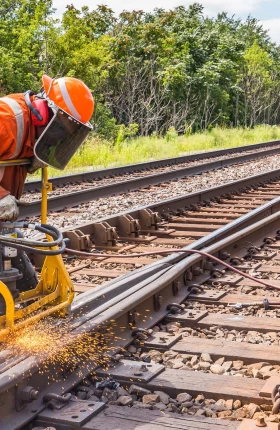Materials processing companies are struggling to hire and retain the workers who keep their machinery running. A severe and accelerating shortage of skilled maintenance technicians is a threat to operational reliability, business continuity, and profitability. As senior technicians retire, institutional knowledge is literally walking out the door.
Downtime due to insufficient maintenance talent has become staggeringly expensive, with unplanned outages costing global industries nearly $1.4 trillion in lost revenue annually. Less experienced technicians take significantly longer to perform routine tasks, exacerbating downtime and diminishing productivity and profitability.
The maintenance talent gap is here to stay, demanding C-suite attention to define long-term solutions. By deploying a portfolio of solutions across outsourcing, demand reduction, and productivity improvement, leaders can turn this structural vulnerability into a competitive strength. Those who move decisively will not only avoid costly downtime but also build an enduring advantage rooted in reliability, agility, and resilience.
Stay ahead with BCG insights on operations
A Rising Strategic Threat
The magnitude of the challenge is stark. In US-based industries, such as pulp and paper processing, industrial-machinery mechanics account for more than 10% of the workforce. These skilled technicians are increasingly in demand, and their overall employment is projected to grow by approximately 16% over the next ten years. (See Exhibit 1.)

Yet the supply of maintenance technicians is not rising to meet the increased demand. The convergence of an aging workforce, a shrinking talent pool, and evolving worker expectations will result in a widening deficit of maintenance technicians over the next decade—leading to higher costs, reduced efficiency, and increased risk of expensive downtime.
Aging Workforce and Evaporating Expertise. The maintenance workforce is aging rapidly. In the US, for instance, studies indicate that the average age of maintenance technicians is around 50, and roughly one-third of the workforce is 55 or older. A significant share of these skilled professionals is expected to retire by 2030, creating a looming expertise gap. Replacing them won’t be easy; many companies already report that 10% to 30% of maintenance jobs remain unfilled, depending on the role and location.
Even when organizations successfully recruit junior technicians, the path to full productivity can take several years. Recent observations at one facility found that junior technicians required up to 3.5 times longer than their experienced counterparts to perform routine maintenance tasks. The additional time was spent troubleshooting, gathering information, verifying quality, and performing rework. This delay led to a loss in plant availability of approximately 25%.
As hiring challenges grow, the departure of senior technicians erodes a company’s most precious resource: tacit knowledge. This often undocumented know-how, estimated to comprise up to 70% of critical maintenance expertise in some sectors, incrementally departs the organization with every retirement.
Shrinking Talent Pool. External factors are also shrinking the talent pool. A cultural stigma around blue-collar work, little emphasis on trade careers in secondary schools, and a societal shift toward professions in the knowledge economy make it increasingly difficult to attract new workers to the field.
Employers face a tight pool of available maintenance technicians, with maintenance and repair occupations seeing a 3% unemployment rate, compared with 5.6% for construction and extraction jobs. In the US and many other developed economies, job vacancies in the manufacturing and process sectors now outnumber available job seekers.
Shifting Workforce Preferences and High Turnover. Compounding these structural issues, worker preferences are evolving. Recent BCG research highlights that GenAI is reshaping how employees think about their careers, with rising expectations for learning opportunities, autonomy, and a sense of purpose. Younger workers, in particular, value technology-enabled roles that provide growth and flexibility over repetitive manual tasks.
Companies that fail to integrate GenAI into maintenance roles risk losing appeal in a competitive labor market. Conversely, organizations that embed AI to simplify troubleshooting, accelerate skill development, and elevate the technician experience will not only expand the effective labor pool but also strengthen retention by satisfying worker aspirations.
High turnover adds to this challenge. At many plants, the turnover rate among technicians with less than three years’ experience is double that of the overall technician workforce. Younger technicians are more willing to leave employers that rely on outdated, manual processes. Unless companies address turnover directly, they face an even steeper path to a stable and resilient maintenance workforce.
Operational Consequences: Why C-Suite Leaders Should Take Notice
The repercussions of the skilled maintenance labor shortage extend far beyond unfilled job postings. The inability to maintain equipment properly leads to a higher incidence of machine failure, increased reliance on reactive maintenance, longer mean time to repair, and escalating contractor costs.
Downtime, whether planned or unplanned, is increasingly costly for firms. A 2024 study by Siemens found that the cost per hour of overall downtime in heavy industries is 1.6 times greater than in 2019, with unplanned downtime costs experiencing a four-fold increase. Across the world’s 500 largest companies, unplanned downtime adds up to nearly $1.4 trillion in lost revenue annually.
This challenge has caused maintenance staffing to become a C-suite priority globally, and particularly in the US. C-suite leaders must recognize this challenge not as a peripheral HR concern but as a direct threat to operational continuity, profitability, and competitive advantage. Addressing it head-on is imperative for business leaders aiming to maintain market leadership in an increasingly constrained labor environment.
A Portfolio of Responses
Companies in materials processing industries often default to outsourcing when faced with immediate maintenance talent shortages. However, true resilience demands a broader, strategically aligned portfolio of solutions that also includes reducing demand and increasing productivity. To choose the best response, companies should consider each solution’s timeframe for implementation, complexity, cost efficiency, and workforce impact. (See Exhibit 2.)

Outsourcing Support
Companies can choose from several outsourcing models depending on their maintenance needs and strategic goals.
Full Outsourcing. Fully outsourcing maintenance can provide rapid access to skilled technicians and reduce internal HR burdens. When implemented well, it can deliver shared value through bundled services across plants, shared efficiency across geographies, and focused oversight.
Contracts should be designed with shared value in mind and include clear KPIs linked to mean time between failure, mean time to repair, and quality control standards. Providers should ensure a mix of experience within their teams so that senior technicians can train and coach junior colleagues. Contract clauses should enable the future in-sourcing of provider teams. A robust contract structure also allows companies to maintain flexibility over time, as economic conditions or internal capabilities evolve.
Companies that fully outsource must take steps to prevent the loss of knowledge and expertise in case they eventually decide to restore internal management. Clear accountability, contractually aligned incentives, and mature operational practices are essential to prevent erosion of valuable capabilities and ensure a smooth, effective handover to in-house staff.
Selective Outsourcing for Surge Capacity. Selective outsourcing provides targeted support during peak demand periods or when specific capability gaps need to be filled. This approach requires detailed planning and clearly defined scope boundaries to avoid inefficiencies and duplication of effort. Success factors include strong upfront planning, clear delineation of responsibilities, and stringent control measures such as precise tracking of work hours. Outcome-linked KPIs—particularly wrench time efficiency and completion of assigned work—are essential. These practices ensure optimal coordination between internal and external teams to maintain operational integrity and efficiency.
Selective Outsourcing to Accelerate Internal Upskilling. Organizations can leverage third-party experts to build internal maintenance capabilities. Contracts should define minimum credentials, such as certifications or experience in a specific system. They should also include training-related KPIs, such as classroom hours delivered or documentation produced. Crucially, these engagements must have an expiration date and ramp-down plan for transitioning full ownership back to internal teams. Proper execution not only addresses immediate skill gaps but also supports long-term workforce development through structured enablement.
Demand Reduction
While addressing talent shortages is essential, successful companies also reduce unnecessary maintenance demand. They do this by implementing maintenance excellence programs and right-sizing preventive maintenance activities, both of which increase reliability and reduce failures.
Maintenance Excellence Programs. These programs reduce maintenance labor hours by streamlining work and increasing equipment reliability; fewer failures translate into reduced maintenance workloads. Such initiatives typically include criticality-based preventive maintenance reviews to eliminate low-value tasks and adjust maintenance frequency through reliability-centered maintenance and failure modes and effects analysis. Maintenance excellence programs also use defect elimination and root-cause failure analysis to prevent recurring issues, and they standardize basic care practices, such as lubrication, alignment, and contamination control. These efforts improve reliability, decrease production losses, and lower overall operating costs.
Predictive Maintenance. Companies use predictive maintenance strategies to further enhance reliability and reduce reactive interventions. Real-time data analytics and condition-based monitoring tools enable proactive troubleshooting, allowing maintenance activities to be scheduled efficiently during planned overhauls or periods of reduced operational activity. This approach minimizes the need for intensive maintenance work during peak operating periods, balancing labor demand and maximizing resource efficiency.
Productivity Improvement
To enhance productivity, successful organizations are deploying various strategies to optimize technicians’ effectiveness while building their long-term capabilities.
Wrench Time Improvement. Optimized wrench time—the actual time technicians spend performing hands-on maintenance tasks—directly enhances productivity, enabling organizations to perform more maintenance with the same or fewer resources. Companies can improve wrench time by eliminating nonvalue-added activities. Examples include minimizing the time technicians spend searching for parts through effective kitting, optimizing travel time via dedicated maintenance routes, and providing standardized toolboxes to ensure immediate access to equipment. Organizations can also prepare “plug jobs”: preplanned maintenance tasks that are ready to be deployed when scheduled work finishes early or is delayed. Finally, they can streamline necessary but low-value activities, such as by standardizing morning meetings and formalizing lock-out/tag-out procedures with clear contact details.
Digitally Enabled Maintenance. Digital productivity tools, such as extended reality (XR) and AI-powered tablets, boost execution efficiency, technician productivity, and job satisfaction. For example, a railway operator increased technician efficiency by nearly 30% through XR-guided workflows.
Digital solutions are now essential components of mature maintenance organizations. But successful adoption must directly address frontline technician pain points rather than simply deploying technology for its own sake. Mechanics and technicians should co-create solutions, tailoring tools to the actual problems they encounter. Success depends on a strong data infrastructure, disciplined change management, and a focus on value over novelty.
GenAI for Knowledge Capture and Support. GenAI offers a powerful solution to the maintenance talent crunch by capturing and codifying institutional knowledge before it is lost to retirements or turnover. By transforming decades of tacit expertise into accessible, interactive guidance, GenAI enables faster onboarding and continuous upskilling of frontline workers. Technicians can access real-time troubleshooting support, learn new procedures on the job, and build confidence in handling increasingly complex systems. This not only helps bridge skill gaps but also enhances employee engagement and career growth opportunities.
Building Internal Talent Pipelines for Long-Term Resilience. Developing in-house talent through apprenticeship programs, trade school partnerships, and structured development tracks is a long-term play with powerful returns. Companies must commit to a three-to-five-year horizon and provide retention incentives, such as bonus plans or credential-linked career paths. Codifying institutional knowledge—such as by pairing new recruits with experienced technicians—is essential to shortening ramp-up time and preserving tribal know-how. A strong training curriculum, reinforced by formal mechanisms to capture and share lessons learned, can make internal talent pipelines a strategic asset. Although it takes time, this investment builds cultural continuity and reduces dependence on external talent—two benefits that grow in value with each passing year.
Execution Matters: Real-World Success Stories
Even the best-designed model can fail without the right governance, accountability, cultural alignment, and overall change management. The following examples highlight how successful organizations are solving the maintenance talent crunch with a tailored approach, grounded in operational realities and business goals.
Building Local Teams with External Support. An ore processing company with operations in more than 20 US locations saw maintenance costs become its fastest-growing expense line. As part of a broader performance transformation, leadership set out to shift from reactive fire-fighting repairs to a prevention-first model. The urgency was acute: critical assets were experiencing rising failure rates, mounting rework, and persistently high mean time to repair. These pressures were compounded by technician turnover exceeding 50% and vacancies stretching beyond five months.
To address the scarcity of skilled talent, the short average tenure of in-house mechanics, and escalating reliability-driven production challenges, we designed a time-bounded contractor strategy. The objective was to upskill the internal workforce and then taper off external spending. Key elements included:
- Competence-Driven Contractor Roles. Every contract position had strict acceptance criteria. These included years of experience in comparable ore-handling environments and demonstrable task-level expertise, such as in replacing conveyor bearings.
- Structured Knowledge Transfer Metrics. For each skill, we set clear time allocations and KPIs to track how quickly internal technicians achieved proficiency.
- Redundant Training Coverage. Contractors mentored multiple trainees on every procedure, ensuring that critical know-how stayed with the company even amid high turnover.
The economics were structured to remain roughly cost neutral: savings from reduced rework and improved productivity offset the cost of temporary specialists. This approach enabled the company to bring in experienced technicians to transfer critical skills internally without increasing overall maintenance spending.
Cutting Shovel Rebuilding Times at an Open-Pit Mine. A remote mining site in northern Canada was taking more than twice as long as planned to complete major midlife overhauls of its large digging shovels. Root-cause reviews identified three recurring execution gaps: workers in scarce specialized trades, especially welders, were hard to mobilize on schedule; shifting breakdown priorities diverted attention, inflating mean time to repair across the fleet during repair-related shutdowns; and late-discovered quality defects delayed restarts.
Because the shovel-rebuilding program was temporary, skill specific, and time critical, the company adopted a surge-outsourcing model designed to guarantee execution discipline:
- Integrated Outsourcing Partnership. The company negotiated a multishovel rebuilding program with a preferred OEM, securing guaranteed resources for successive outages. The OEM benefited from volume certainty while the mining company gained cost transparency.
- Pre-outage Quality Assurance. The company ensured that every craftsperson had completed the appropriate training and certification programs before arriving on site, reducing error rates from day one.
- Stage Gate Inspections. Clear pass-fail checkpoints, often photo verified, were built into the work sequence, ensuring that defects were caught and corrected well before recommissioning.
The program had impressive outcomes: shovel-rebuilding durations came back within the planned time frames, fleet-wide mean time to repair remained stable during outages, and total spending declined through right-first-time execution and smoother restarts.
Boosting Frontline Productivity with GenAI Troubleshooting Support. A large North American renewable-energy operator faced rising productivity and retention challenges. Junior technicians struggled with steep learning curves and leaned heavily on senior experts already stretched thin by constant troubleshooting calls. Inconsistent documentation, multiple digital support systems, and high rework rates extended outage durations and reduced uptime. Leadership needed a way to capture institutional knowledge, standardize troubleshooting, and reduce workforce strain.
We co-developed a GenAI-powered “technician copilot” to embed expertise directly into technicians’ daily workflow:
- Unified Knowledge Hub. Fault code wikis, OEM repair manuals, and live work order histories were consolidated into a single conversational interface.
- Real-Time Expert Guidance. AI-generated troubleshooting steps and asset-specific recommendations give junior technicians on-demand, expert-level support.
- Continuous Learning Loop. Every technician interaction enriched the knowledge base, improving documentation quality and accelerating workforce upskilling.
The initiatives boosted productivity by 5% to 10%, reduced the duration of jobs by 15% to 20%, and cut rework rates, while enhancing technician confidence and engagement.
Strategic Imperatives for Industry Leaders
Three strategic imperatives provide a structured framework to guide business leaders in maintaining operational continuity and driving future growth.
Recognize labor risk as a strategic priority. Business leaders must acknowledge the gravity and enduring nature of the maintenance labor shortage. Viewing it merely as an HR issue underestimates its potential impact on operational continuity and business outcomes. C-suite leaders must elevate maintenance workforce planning into strategic decision making, ensuring the necessary attention, resources, and commitment at all organizational levels.
Develop a portfolio of complementary solutions. Organizations should adopt a portfolio mindset, blending immediate stopgaps with long-term capability building. Crucially, integrating cutting-edge tools such as GenAI can rapidly enhance internal capabilities, effectively capturing and transferring vital institutional knowledge across workforce generations.
Commit to knowledge capture and organizational resilience. Investing in comprehensive knowledge management systems, supported by a culture committed to continuous learning and innovation, creates enduring competitive advantages. Companies that excel in preserving and scaling technician expertise will not only weather the labor shortage but also emerge stronger, more agile, and strategically resilient.
The shortage of skilled maintenance technicians is no longer a background concern. It’s a defining challenge for materials processing companies. But it also creates an opening for those ready to lead. Companies that move now, with bold workforce strategies, digitally enabled tools, and deliberate knowledge transfer, will not only reduce downtime but also build a competitive edge. By investing in these capabilities today, leaders set the foundation for resilience, agility, and operational excellence that will support organizational success well into the future.






